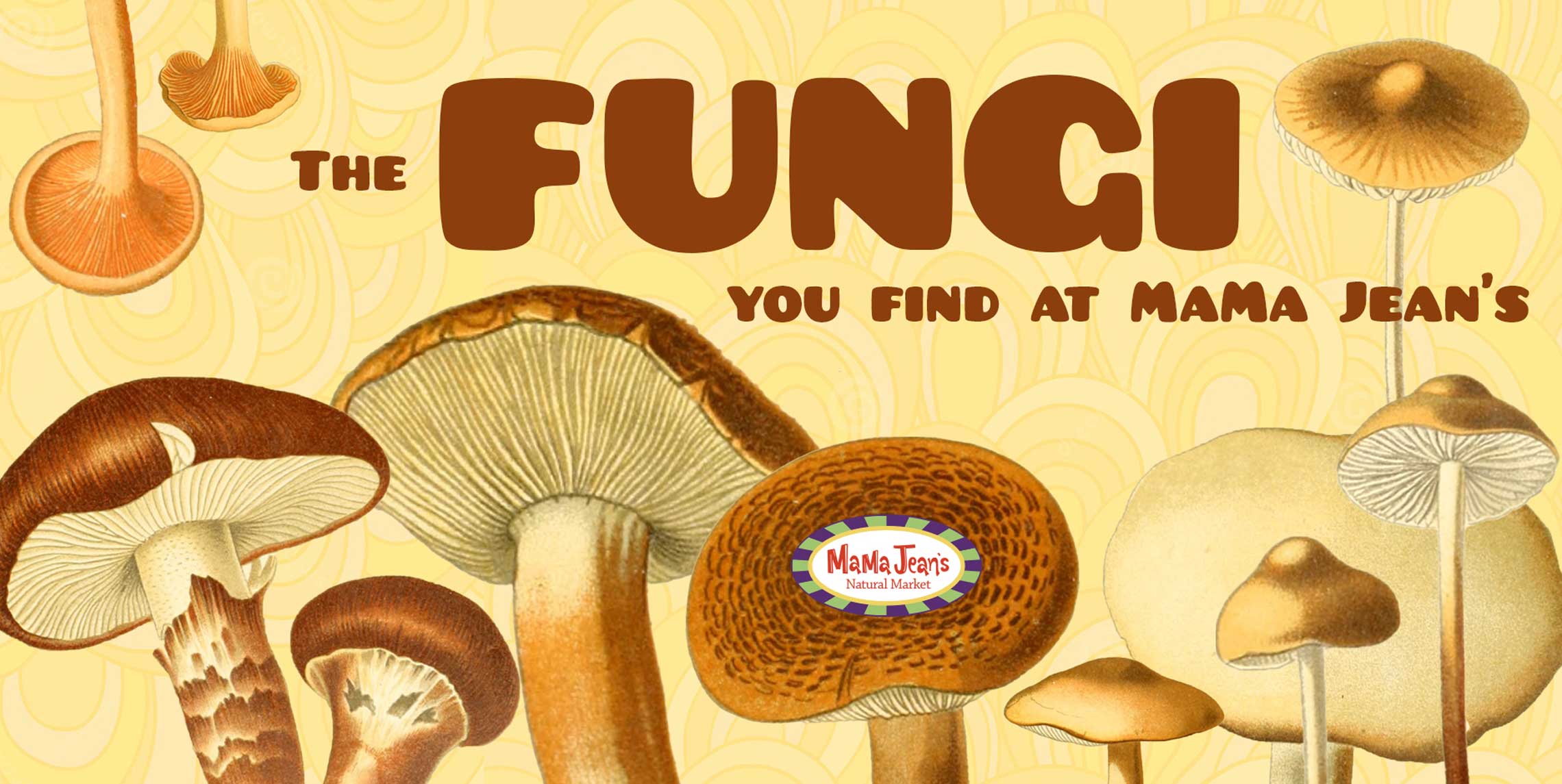
Fungi are a billion years old. Probably. Maybe even older – like, another half a billion years older. Maybe more.
Stop to process that for a second.
If you look at the history of the earth as a 12hr clock, man shows up at about 11:59 and 58sec. Civilization starts about a tenth of a second ago.
Fungi have been here since at least 8:00. Maybe longer. Maybe a lot longer.
Twice, including the start of life on land and the single largest extinction event in Earth’s history, fungi were the dominant organism on the planet for MILLIONS of years.
It is estimated that 99 percent of all species which have lived on earth up to this point are now extinct. Not fungi – quite the opposite. About 100,000 species of fungi are currently known, including many of the yeast, mold, and mushroom species we’re all familiar with, but it is estimated that we have only identified 5% of ALL the fungi that exist. There may be as many as 1.5 – 5 MILLION species out there (FACT: there’s only one species of us). Fungi are their own kingdom of organism separate from animals and plants. Even better, fungi are more related to animals – they’re less like a tree and more like us.
Fungi grow in every part of the world and almost any sort of environment, including many extreme environments where no other organism can live. Some can even survive the vacuum, lethal temperatures, and intense radiation encountered during interstellar travel. This has led to speculation that fungi may actually have come here from space and, in fact, may be the very seed of life on earth itself.
So fungi are really old, there’s a whole lot of them, we may be made from them, and they can live through ANYTHING. They’ve been really good at staying alive perhaps as long as staying alive has been a thing (take that, Mr. Gibb). Turns out, they developed a lot of clever ways to do this and we’re really just starting to understand how useful those things may be to us.
Now, fungi have been used traditionally for thousands of years for culinary purposes, religious purposes (those are the “fun”-gi), and medicinal purposes. Reishi mushrooms were used for some of the same things 2,000 years ago which they’re being used for now. But, the biggest jump forward came in the early 20th century with perhaps one of the most important developments in human history: antibiotics. Remember how someone sneezed on you and you’re not dead now? Thanks, antibiotics!
Various molds and mushrooms had been used to treat infections for a couple thousand years – my favorite example is a 17th century Polish recipe for wounds involving spider webs and wet bread – but late in the 1800’s we started to understand that certain molds, particularly penicillin, inhibited the growth of different bacterias. Thus began a race forward to discover and exploit the medicinal properties of fungi, a race which accelerated over the course of the last 150 years. Fungi are insanely good at adapting and staying alive (“iiiiiive”). As a result, we have gained antibiotics (starting with penicillin), fungicides (naturally), cholesterol inhibitors (“statins”), psychotropic drugs (to treat depression and alcoholism), immunosupressants (for treatment of everything from multiple sclerosis to organ transplants), and anti-carcinogenic (“anti-cancer”) drugs.
A surprising number of potentially valuable fungi are available over-the-counter, and many of them are well-studied and quite effective. Just like any other supplement product, there are varying levels of quality and potency, so you’ll want to make the right choice. Here are just a few of the many fungi, and the recommended brands, you’ll find at your friendly, neighborhood MaMa Jean’s!
Reishi (ganoderma lucidum)
Recommended Brand: Host Defense
- Also known as “Lingzhi,” used in traditional Chinese Medicine for over 2,000 years, it was referred to in ancient medical texts as “The Mushroom of Immortality.”
- Supports greater immune function.
- Anti-inflammatory/Anti-allergenic: useful in treating various respiratory issues, from bronchitis to asthma.
- Anticonvulsant: useful in treating certain types of seizures.
- As an anticarcinogenic, it has been studied as a successful adjuvant to broader chemotherapy regimens, and has shown positive results with both colon and ovarian cancer.
- Has a positive impact on blood-sugar levels for diabetics.
- May positively impact gut flora (your “probiotics”) as they relate to obesity.
Cordyceps (there are over 400 species)
Recommended Brand: Host Defense
- Used in both traditional Chinese and Tibetan medicine for over 2,000 years.
- A parasitic fungi, Cordyceps primarily grow on and in various insects and arthropods (spiders, scorpions, etc.) by replacing their tissue with it’s own. Some cordyceps actually exert control over the mind of the host, causing the creatures to climb to an optimal location for growth on a plant, then latch on and die. It is estimated they developed this ability at LEAST 48 million years ago. (Be impressed.)
- The most common is Ophiocordyceps Sinensis, otherwise known as “Caterpillar Fungus.” I’ll let you guess how it got the name.
- Frequently used on it’s own or in combination with Reishi to improve respiratory function.
- Used to boost immune function.
- Potentially anticarcinogenic.
Lion’s Mane (hericium erinaceus)
Recommended Brand: Host Defense, New Chapter (“Mind Force”)
- Also known as “Satyr’s Beard,” “Pom Pom Mushroom,” and “Bearded Tooth Mushroom.”
- Another one of those things that the Chinese have been all over since forever, Lion’s Mane is praised for its neuroregenerative effects (it’s great for your brain).
- Looked at as a possible anti-dementia agent for people with Alzheimer’s and other neurodegenerative disorders.
- Has been shown to stimulate nerve growth in crushed nerve fiber.
- A double-blind study published in 2009 showed mild cognitive improvement in individuals with mild impairment (it might make you smarter).
Maitake (frondosa)
Recommended Brand: Host Defense
- Just assume that the Chinese had this one on lockdown too, cause they did. (The Japanese also!)
- Normally about the size and shape of a potato, they can grow up to 100lbs. Earning them the title “The King of Mushrooms.”
- Rich in minerals (such as potassium, calcium, and magnesium), various vitamins (B2, D2, and niacin), fibers and amino acids
- Research has shown it to be excellent for a variety of Cardiovascular issues.
- Naturally lowers blood-sugar.
- Supports both the innate (built-in) and the adaptive (the one we build for ourselves) immune systems. Especially due to it’s high Beta-Glucan content.
- Studies showed positive results for it’s impact on the immune systems of breast cancer patients.
Red Yeast Rice (“Hóng qū mǐ” literally: “red yeast rice”)
Recommended Brand: Bluebonnet, MaMa Jean’s
- Yup. Ancient China again. Really. Just deal with it.
- A bright, reddish-purple rice, acquiring its color as it’s fermented with the mold Monascus Purpureus.
- This is where we get “statin” drugs from. Statins inhibit the ability of the liver to synthesize cholesterol, which is actually where most of the cholesterol in our bloodstream comes from, not our diet (still important to eat right though).
- Statins are BIG business. In 2003, Atorvastatin (just one of the many available) became the best-selling pharmaceutical in history. EVER. It is estimated that by 2020 the statin market alone could be worth $1trillion.
- Red Yeast Rice, the substance on which these are all based, can be readily found in just about any health food store worth its salt.
- In 2006, a meta-analysis of 93 different studies on Red Yeast Rice supplements showed that, in trial, RYR demonstrated results in a range comparable to those of pharmaceutical statins. A subsequent study in 2008 of 5,000 former heart-attack patients actually showed results BETTER than those of prescription statins.
S. Boulardii (saccharomyces boulardii)
Recommended Brand: Jarrow
- A tropical yeast first discovered by the French scientist Henri Boulard in 1923. (NOT the Chinese. Vive la France!)
- A “probiotic” organism, it thrives at a uniquely high temperature – 98.6 F (that is, the ideal temperature of you).
- The number one thing to take for “C. Diff” (Clostridium difficile) infections, which are a nasty business. If you come down with one, your doctor is likely to send you for this.
- Excellent for E. Coli infections, Irritable Bowel Syndrome, and Inflammatory Bowel Disease.
- Used to treat a wide variety of diarrheal conditions.
- Boosts immune function.
- Has positive impacts on blood sugar levels.
- It even has an anti-inflammatory effect. It just couldn’t help itself.
Brewer’s Yeast (saccharomyces cerevisiae)
Recommended Brand: Bluebonnet
- Definitely used by the Chinese since ancient times, but pretty much everyone else too.
- The name is no coincidence. This is the very organism that brought us happy hour and all of the best Super Bowl commercials. (Beer. It gave us beer. Wine too!)
- Viewed as a “model organism.” That is, it has so much in common with so much life that studying it helps us understand how life itself works.
- Rich in B-vitamins, which boost energy levels.
- High in Chromium, it helps to balance blood sugar.
- It’s naturally probiotic and can aid in a number of digestive issues, including diarrhea and IBS.
- Between its B-vitamin and mineral content it’s an excellent supplement for hair, skin, and nail health. Cause, we all want to be pretty.
As we move forward, both in nutraceutical and pharmaceutical medicine, fungi may be a big part of our future. They’ve been around a long time, a lot longer than us, and they’ll likely be around long after us. They’ve developed strategies for survival we haven’t even discovered yet. They’re tough, and when you’re the young guy in a tough room (us), you find the oldest, toughest person in there and try and figure out how they made it as long as they have. We’ve already gleaned many secrets from these survivors. Come find some fungi at your friendly, neighborhood MaMa Jeans!
Written by Ran Cummings

